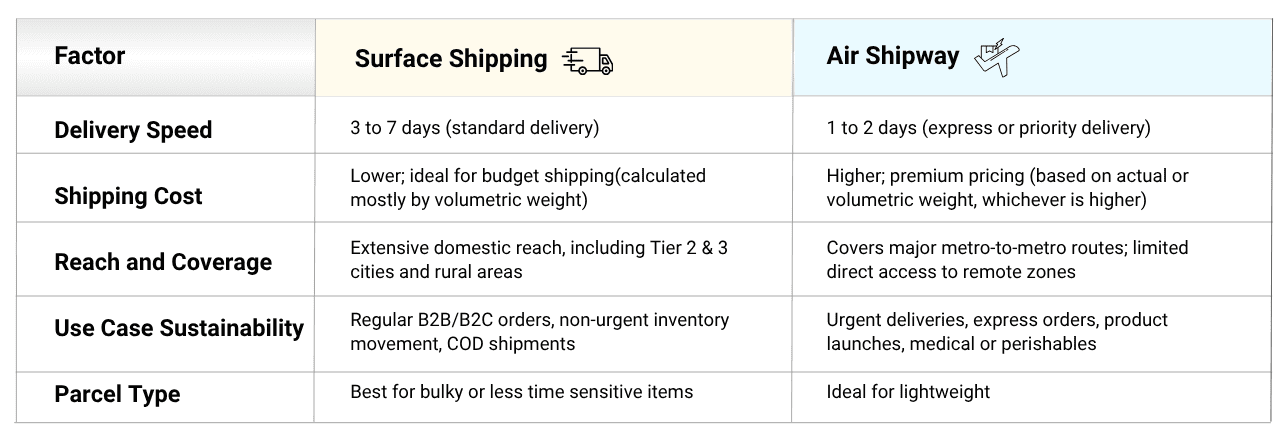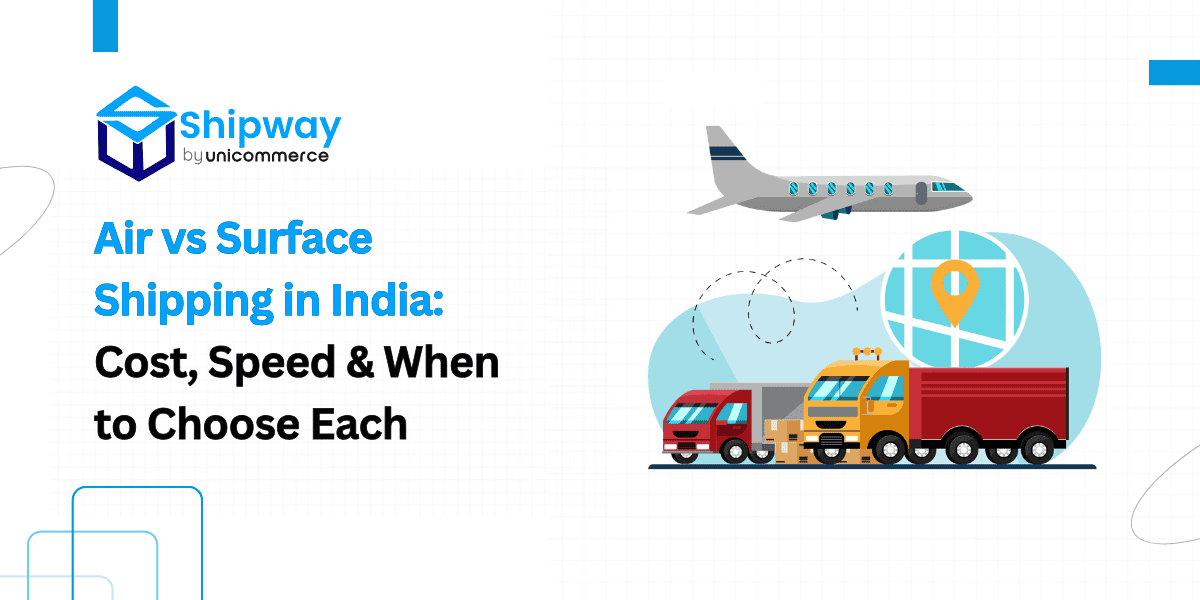In India’s fast-growing e-commerce and logistics ecosystem, delivery speed and cost are two critical factors that directly impact customer satisfaction and business profitability. If you’re a D2C brand, marketplace seller, or small business owner, choosing between air shipping and surface shipping can significantly influence your logistics strategy.
This decision becomes even more crucial when you’re trying to determine which shipping method best suits your needs: air shipping or surface shipping? While both are primary modes of freight transportation in India, each comes with its own set of pros and cons.
If you’re unsure which mode to choose, this blog breaks down the key differences between air and surface shipping in India, comparing them across factors like cost, speed, and delivery coverage. Whether you’re aiming for faster courier delivery times or looking to optimize logistics costs in ecommerce, check out this blog to understand the difference between air vs surface shipping and much more.
What is Air Shipping?
Air shipping refers to the transportation of goods through aircraft, either commercial passenger flights or dedicated cargo planes. It is the fastest mode of shipping available in India, primarily used when delivery speed is a top priority.
In ecommerce and retail logistics, air shipping plays a critical role in enabling same-day, next-day, or 48-hour deliveries across large distances. For example, a seller in Delhi can ship a package to Bangalore or Mumbai and have it delivered the next day using air transport, something surface shipping cannot achieve within the same timeframe.
Air shipping is commonly offered by courier partners as “air express” or “priority delivery” services. It is typically more expensive than road or rail shipping, as the cost is calculated based on actual weight or volumetric weight, whichever is higher. However, the advantages go beyond speed. Air shipping often comes with better handling, lower transit risk, and more predictable timelines, as aircraft routes are less affected by road conditions.
What is Surface Shipping?
Surface shipping is the most widely used form of logistics in India, where goods are transported over land using road or rail networks. Unlike air shipping, which prioritizes speed, surface shipping focuses on cost-effectiveness and carrying capacity, making it ideal for everyday business operations, especially when time sensitivity is low.
Whether you’re shipping within the same city or across states, it allows you to move large or heavy shipments without burning through your logistics budget. It’s particularly well-suited for standard delivery timelines, where orders can take anywhere between 3 to 7 days, depending on the distance and delivery zone.
But there’s more to it than just cost. Surface shipping supports a broader delivery network, reaching pin codes that aren’t always serviced by air routes. That’s why it’s commonly used by e-commerce sellers, wholesalers, FMCG distributors, and B2B brands looking to reach smaller towns, dark stores, or local warehouses.
Surface Shipping vs Air Shipping: Key Differences
Choosing between air and surface shipping in India depends on multiple operational factors. Here’s a side-by-side comparison to help you evaluate the two modes based on speed, cost, coverage, and more:

Why Choosing the Right Logistics Partner Matters?
Selecting the right logistics partner is crucial, especially when you’re handling speed, cost-efficiency, delivery reliability, and nationwide coverage. Whether you’re shipping via air or surface, your ability to ensure on-time deliveries, minimize RTOs, and keep logistics costs under control depends heavily on how well your courier partner aligns with your operational goals.
Let’s break down why this choice can make or break your delivery experience.
Here’s Why It Matters-
- Impacts Delivery Timelines: Even if you choose the fastest shipping mode, poor coordination or delayed pickups can result in missed SLAs. A good logistics partner ensures consistent turnaround times and faster order fulfillment.
- Affects Customer Satisfaction: Late deliveries, poor tracking, or damaged products can break customer trust. The right courier ensures real-time tracking, safer handling, and professional last-mile service.
- Determines Shipping Costs: Courier rates, RTO charges, fuel surcharges, and packaging fees can vary wildly. Reliable partners help you control logistics costs while maintaining service quality, especially for a surface and air shipping mix.
- Supports Scale & Reach: As your business grows, you’ll need partners that can scale with you, offering PAN India delivery, air-ground flexibility, and integrations with marketplaces or OMS platforms.
- Influences Return Handling & Reverse Logistics: Returns and failed deliveries are inevitable in online selling. An experienced logistics provider handles reverse pickups, faster RTOs, and inventory reconciliation, reducing friction in your operations.
When Should You Use Air vs Surface Shipping?
There’s no one-size-fits-all answer when it comes to choosing between air and surface shipping. Each method is suited to different delivery scenarios, and the right choice depends on your product type, urgency, customer location, and cost constraints.
Here’s the most common business use cases for each method:
Use Air Shipping When:
- You need to deliver urgent or express orders within 24–48 hours (e.g., festive sales, priority customers).
- Your products are lightweight but high in value such as gadgets, cosmetics, or luxury items.
- You’re shipping between major metro cities with strong air cargo connectivity.
- You offer express delivery at checkout and need to meet tight SLAs.
- You’re delivering medical, wellness, or perishable goods that have a short shelf life or regulatory deadlines.
- You’re sending critical B2B samples or spares that could delay operations if late.
Use Surface Shipping When:
- You’re shipping bulky or heavy goods (e.g., furniture, kitchen appliances, fitness gear).
- Your orders are non-urgent and customers are comfortable with 3–7 day delivery timelines.
- You’re fulfilling orders in Tier 2, Tier 3 cities, or rural pin codes where air service is limited.
- You’re doing inventory transfers between warehouses or dark stores.
- You’re shipping COD or high-return-risk orders, where cost-saving is key.
- Your brand focuses on logistics cost optimization at scale.
Why You Should Use a Shipping Aggregator to Choose Between Air and Surface Shipping
Manually deciding whether to ship an order via air or surface can become overwhelming when you’re processing thousands of orders daily, across varied pin codes and delivery expectations. That’s where a shipping aggregator becomes essential.
At Shipway, it helps you make real-time decisions by automating the selection of the most appropriate shipping mode for each order. Rather than guessing on fixed rules, you get intelligent mode selection that balances speed, cost, and serviceability.
Key Reasons to Use an Aggregator for Mode Selection
1. Deliver with Confidence
Instead of manually choosing between air or surface every time, an aggregator auto-selects the best-fit shipping mode based on delivery deadlines, location, and cost efficiency.
2. Smart Courier-Mode Matching
Aggregators assess all live courier options for every shipment; some may offer air service at competitive rates, while others may excel at surface delivery in specific zones. You always get the best match.
3. Balance Cost vs Speed at Scale
Not every order needs air shipping. Aggregators help you use air only when speed is critical and default to surface when it’s more economical, helping you optimize shipping spend without missing SLAs.
4. Improved Delivery Performance
By allocating the right mode for each shipment, you’re more likely to meet Estimated Delivery Dates (EDDs), reduce RTOs, and improve customer satisfaction without overspending on logistics.
5. Dynamic Routing Based on Business Rules
You can configure your own logic:
- “Use air for prepaid metro orders.”
- “Use surface for COD shipments over ₹1000”
- Aggregators apply these rules automatically, ensuring consistent and efficient decision-making.
How Shipway Simplifies E-commerce Logistics with Courier Aggregation
Shipway is a powerful shipping aggregator that helps ecommerce businesses streamline their shipping operations by offering access to multiple courier partners, automated tracking, and seamless platform integrations. This leads to faster deliveries, reduced shipping costs, and better customer satisfaction.
Here’s how it works:
- Multiple Courier Access: As a courier aggregator, Shipway is integrated with numerous courier partners. Businesses can compare rates and delivery speed- surface or air and choose the most cost-effective option for every shipment.
- Automated Tracking & Notifications: Shipway provides real-time tracking updates to both businesses and end customers. Automated alerts via WhatsApp, email, and SMS keep all parties informed, enhancing transparency and the post-purchase experience.
- Fraud Detection & Risk Control: The system flags high-risk orders to help businesses reduce RTOs (Return-to-Origin) and associated losses through early fraud detection.
- Smart Rate Comparison & Route Optimization: Businesses can easily compare courier rates and optimize delivery routes, ensuring efficient and economical shipping for both surface and air shipments.
Final Thoughts
Since air and surface shipping serve different purposes, understanding when and how to use each can significantly improve delivery efficiency and cost control. Surface works best for planned, high-volume shipments, while air is suited for time-sensitive or long-distance orders.
Therefore, businesses that align shipping modes with delivery timelines, geography, and cost structures are better positioned to meet customer expectations without inflating logistics spend.
Shipway supports this balance by giving businesses access to multiple courier partners, rate comparisons, and real-time tracking- all in one platform. Explore how Shipway can simplify your shipping operations and optimize your ecommerce logistics with ease!
A
Which is cheaper for regular e-commerce shipping air or surface?
Surface shipping is more cost-effective for most orders, especially bulk or non-urgent ones. Air shipping should be used selectively for high-priority deliveries due to its higher rates.
Does air shipping always guarantee faster delivery?
Generally yes, but it also depends on courier capacity, destination zone, and cut-off timings. In some regions, premium surface services may offer similar speeds at a lower cost.
Can I use both air and surface for different orders?
Yes. Many sellers adopt a mixed approach, using air for express orders and surface for standard or COD shipments to balance cost and speed.
How do I automate courier selection based on delivery urgency or location?
With platforms like Shipway, you can set rules or enable AI-based courier assignment to auto-select the ideal shipping mode and partner per order based on zone, SLA, or product type.
What’s the best way to track and manage both air and surface shipments together?
Instead of manually tracking each courier, use a unified dashboard that syncs all shipments, air and surface into one view, with real-time updates, automated notifications, and performance reports.



